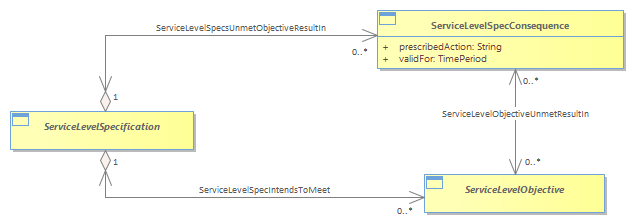Figure SO.42 - ServiceLevelSpecConsequences

|
Project:
|

Figure SO.42 - ServiceLevelSpecConsequences : Class diagram
Customer-facing Product KQIs, such as the number of trouble tickets opened for a Product, characterize Customer Service Level Agreements. Service KQIs, such as the maximum web server unavailability time that is permitted, represent an aggregation of Service KPIs or a simple one-to-one mapping to a Service KPI, and characterize internal and engaged party Service Level Agreements. Atomic Service KPIs, such as the maximum IP packet loss ratio, do not characterize Service Level Agreements, but form the basis for the determination of KQIs. Please see the SLA Management Handbook (GB917) for additional examples and the Wireless Services Measurement Handbook (GB923) for more details about KPIs and KQIs.<br/>Violations to Service Level Agreements usually result in some consequence for the provider of the Service. The consequence could be a general one that applies to any objective violation, or the consequence could be associated with a specific objective. An example of a consequence is a discount applied to a customer’s bill if the number of trouble tickets for a Product exceeds some number over a specified period of time. The figure below shows how consequences of violating a Service Level Agreement fit into the Service Level Specification model.<br/>No attempt was made to build a detailed model that represents the prescribed actions. Rather, the above model is intended to be an extensible framework that enables each adopter of the model to customize their extensions for this business entity.<br/>
|



